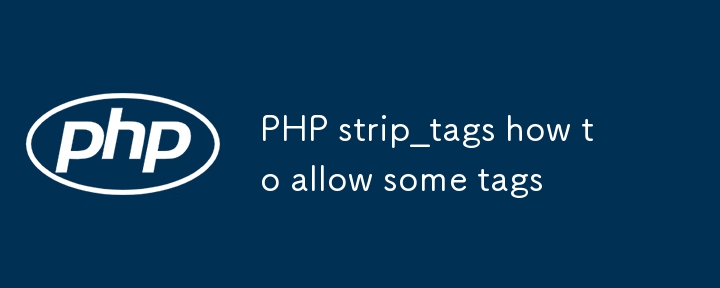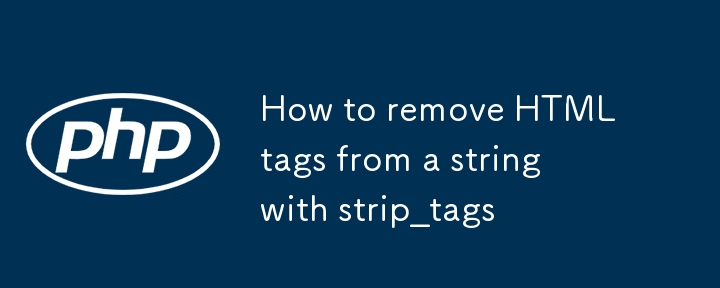Found a total of 10000 related content

What is the label tag in an HTML form and why is it important?
Article Introduction:When using HTML forms, tags must be used to improve accessibility and user experience. The tag is associated with the input element in two ways: 1. Use the for attribute to match the input's id; 2. Wrap the input inside the label tag. It enables screen readers to correctly read form information and add click areas to improve usability on mobile devices. Best practices include always pairing tags for input, using clearly descriptive text, and avoiding substituting tags with placeholder only.
2025-07-06
comment 0
356

Introduction to PhpDoc
Article Introduction:Core points
PhpDoc (PhpDocumentor) is a powerful tool that helps developers write code documents through special format annotations. It can generate documents in multiple formats, such as HTML, PDF, and CHM, which can be extracted through a web interface or command line interface.
PhpDoc uses DocBlocks (multi-line C-style comments) to document code blocks. DocBlocks contains three optional parts: a short description, a detailed description, and a tag. The tag starts with the @ symbol and specifies additional information about the code.
The PhpDoc package is used to group relevant code elements in the generated document. You can use file-level or class-level
2025-03-01
comment 0
1049

SQL for Personalization Engines
Article Introduction:The core role of SQL in the personalization engine is reflected in the structured extraction of user behavior data, the construction of user portrait tag systems, and real-time recommended data preparation. First, through SQL cleaning and aggregation of raw log data, features such as user clicks, page access type can be extracted; second, SQL batch calculation and update user tag table to realize the definition of tags such as high-value users, technology enthusiasts, etc.; finally, through window functions or collaborative filtering pre-calculation, real-time feature and co-occurrence frequency data for recommendation models can be generated to support the efficient operation of the personalized recommendation system.
2025-07-18
comment 0
258

Implementing HTML `input` `placeholder` Text
Article Introduction:To add placeholder text, use the placeholder attribute in the input tag; the placeholder text should be concise and clear, and should not replace the tag or indicate required items; you can use CSS pseudo-elements to customize the placeholder style, but be careful of compatibility and accessibility. The specific steps are: 1. Add the placeholder attribute to the input tag to display the prompt text; 2. Write clear and short prompt content to avoid complete sentences or key information; 3. If you need to modify the style, you can adjust the color, font, etc. through the input::placeholder selector; 4. Pay attention to ensuring that the text is highly readable and avoid affecting the user experience.
2025-07-19
comment 0
121

jQuery Function to All Clear Form Data
Article Introduction:This article describes several practical ways to use jQuery to clear form data from Karl Swedberg's website. These methods can clear all data in the form, including text input boxes, drop-down lists, radio buttons, check boxes, etc.
Method 1: General Function
The following function iterates through all input elements in the form and clears their data according to the element type:
function clearForm(form) {
$(':input', form).each(function() {
var type = this.type;
var tag = this.tag
2025-03-02
comment 0
694

What is the placeholder attribute in form inputs?
Article Introduction:The Placeholder property should display prompt information when the input box is empty when it is used for form input. Its main purpose is to improve the user experience through examples. First, display format examples in the input box, such as the phone number input box can display "(123)456-7890", and the user name input box can prompt "at least 6 characters"; second, it cannot replace the tag and verification function, and needs to be used with the tag to ensure accessibility; third, it is compatible with modern browsers. Old browsers such as IE9 and earlier versions do not support it, and can be processed through JavaScript fallback scheme; fourth, styles can be adjusted through CSS specific syntax, such as setting color and font style.
2025-06-22
comment 0
814

How to find the Windows product key in BIOS/UEFI?
Article Introduction:To view the Windows product key preinstalled on your computer, you can first use the command prompt: run as an administrator and enter wmicpathsoftwarelicensingservicegetOA3xOriginalProductKey; secondly, it can be extracted through PowerShell input (Get-WmiObject-query'select*fromSoftwareLicensingService').OA3xOriginalProductKey; in addition, you can use third-party tools such as ProduKey to read directly, but you need to download it from the official to ensure security. It should be noted that some brands of machines
2025-06-27
comment 0
606

Making Form Fields Mandatory Using the HTML5 Required Attribute
Article Introduction:The required attribute is used to set fields that must be filled in in web forms. When using it, you can directly add the required keyword to the input tag; it can be used with various input types, textarea and select; it is also recommended to combine label to improve user experience, and more complex verification rules can be achieved by cooperating with other verification attributes such as minlength, maxlength, pattern, etc.
2025-07-04
comment 0
435

How to add a placeholder text in an HTML input field?
Article Introduction:The method to add placeholder text in the HTML input box is to use the placeholder attribute, which specifically includes the following steps and precautions: 1. The basic writing method is to directly add the placeholder attribute in the input tag, such as; 2. It is recommended to use it with the label tag to improve accessibility and user experience. For example, the user name input box should combine label and placeholder; 3. Pay attention to the use of CSS when customizing the style::placeholder style, and the color should not be too light; 4. Placeholder should not be relied on as the only explanation, and important tips should be presented through label or additional text; 5. Test the performance of the mobile terminal, because different platforms may differ; 6.
2025-07-08
comment 0
512

HTML `input` `autocomplete` Attribute for User Experience
Article Introduction:The autocomplete attribute is an attribute in HTML that controls whether the input box is enabled for automatic filling function. It can improve the user experience by using it reasonably. The basic usage is to set autocomplete="on" or autocomplete="off" in the input tag, and also supports keywords such as "email", "username", "address-line1" to help the browser more accurately identify the purpose of the field. Suitable scenarios include username, email, password fields on the login registration page; checkout or delivery address
2025-07-21
comment 0
862

Setting Default Values for Form Inputs with the HTML value Attribute
Article Introduction:The most direct way to set the default value of the form input box is to use the HTML value attribute. The value attribute is used to specify the initial value of the form element, such as:. Common elements that support this attribute include text input boxes, password boxes, radio buttons, check boxes (need to be selected by default with checked settings), submit buttons, etc. Correct usage methods include setting strings for text input, setting legal values for numeric input, and transmitting hidden fields. Notes include: avoid unescaped special characters and elements with selected instead of value, and default values should be written in the tag content. Rational use of value can improve user experience and reduce input burden.
2025-07-13
comment 0
444

How do I use the type attribute to specify the type of input field?
Article Introduction:The type attribute in the HTML form is used to specify the input type, which affects the performance and function of the input box. Common types include: 1.text is used for text input; 2.password is used to hide passwords; 3.email is used to verify mailbox format; 4.number is used to limit digital input; 5.date provides date selector; 6.checkbox and radio implement multiple or single-select; 7.submit creates submission button. When using it, you can directly add type attributes to the input tag and set corresponding values. You can combine placeholder, min, max, required and other attributes to enhance the interactive experience. At the same time, pay attention to selecting according to the device optimization type to improve usability.
2025-06-30
comment 0
632

Adding placeholder text to input fields with HTML5 attribute.
Article Introduction:In web design, use the placeholder attribute of HTML5 to add prompt text to the input box. This property is directly added to the input or textarea tag, and the value is the prompt content, such as:. When the user clicks on the input box, the prompt text will automatically disappear. Notes include: 1. The placeholder is light in color and cannot replace the label tag; 2. It is not recommended to be used for important instructions, and some screen readers may not read; 3. Old versions of browsers such as IE9 and below do not support them, and they must be processed compatible; 4. The content should be concise and clear, avoiding vague descriptions or as required instructions; 5. The style can be adjusted through CSS, but it should not replace the verification prompt; 6. The mobile terminal may truncate the prompt text and must be kept short. Master these key points
2025-07-05
comment 0
667

The `autofocus` Attribute in HTML Forms
Article Introduction:autofocus is a boolean property in HTML that automatically targets the specified form element when the page is loaded. 1. It is implemented by directly adding to or in a tag, such as; 2. After the page is loaded, the cursor will automatically appear in the element, which is suitable for scenes that require quick input, such as search boxes, login pages, etc.; 3. Only one element of a page can use autofocus, otherwise only the first one will take effect; 4. Its advantages include saving user operations, guiding user behavior, and enhancing barrier-free experience; 5. It is recommended to use a single input item, expected immediate input or clear process interface; 6. Abuse in complex forms or modal boxes should be avoided to interfere with users; 7. More flexible control can be achieved through JavaScript replacement
2025-07-20
comment 0
549

How to set a default value for an HTML input field?
Article Introduction:To set the default value of the HTML input box, the value attribute is mainly used. The specific methods are as follows: 1. Add the value attribute to the tag, such as the default value will be displayed when the page is loaded; 2. Distinguish between value and placeholder, the former is the actual default value, and the latter is only the prompt text; 3. The default value can be dynamically modified through JavaScript, such as using document.querySelector("input[name='username']").value="NewDefault"; to implement update operations in interactive logic.
2025-07-09
comment 0
211

How to set the maximum length for an input field in HTML?
Article Introduction:The way to limit the maximum length of an input box in HTML is to use the maxlength attribute. The specific operations are: 1. Add maxlength="number" to the or tag to limit the number of characters entered by the user; 2. Note that this property is only valid for text types, such as type="text", type="password" and textarea, which may behave inconsistently to type="number"; 3. Real-time word count prompts can be combined with JavaScript to improve user experience; 4. Front-end restrictions can be bypassed, so the input length and
2025-07-06
comment 0
924

PHP strip_tags how to allow some tags
Article Introduction:strip_tags can specify the reserved HTML tags through the second parameter. For example, strip_tags($input,'') can retain and tag. Common retained tags include,,,,,,, and (need to be used with caution). When using, you should avoid retaining,,, and other dangerous tags, and pay attention to the security of src. In actual applications, it is recommended to test and combine functions such as htmlspecialchars to ensure security.
2025-07-12
comment 0
501

How to create a read-only input field in HTML?
Article Introduction:The way to create a read-only input box in HTML is to use the readonly property, which allows the value to be submitted and the copy content can be optionally copied. The specific operation is to directly add readonly attributes to the tag, such as:; it can also be dynamically controlled through JavaScript, such as document.getElementById("myInput").readOnly=true; Different from disabled, the readonly input box data can be submitted, the style is consistent with the normal input box and supports focus, while disabled does not submit data, the style is gray by default and cannot be focused; it can also be combined with CSS to improve the experience, such as setting background color and border for distinction.
2025-07-16
comment 0
571

How to remove HTML tags from a string with strip_tags
Article Introduction:strip_tags() is a function in PHP used to remove HTML and PHP tags. By default, all tags will be removed and text content will be retained. You can also selectively retain the specified tags through parameters. 1. The method to use strip_tags() to remove all HTML tags is to directly pass in a tagged string, such as strip_tags($input), at which time all tags are deleted; 2. If you need to keep a specific tag, you can specify the allowed tags in the second parameter, such as strip_tags($input,''), and only the tags and their contents are retained; 3. Notes include: strip_tags() cannot prevent XSS attacks and the behavior may be due to version when processing incomplete tags.
2025-07-16
comment 0
385

How do I use the element to represent keyboard input?
Article Introduction:The key to using tags to represent keyboard input is to understand its applicable scenarios and match them with HTML elements. 1. Applicable scenarios include display shortcut keys, command line instructions and game operation instructions; 2. The basic usage is to place the keyboard input content in the tag, such as Enter; 3. It can be used in a nested manner, such as displaying command line interaction; 4. Adding styles (such as borders, rounded corners, background colors) through CSS can enhance visual effects; 5. Complex key combinations can improve readability by adding class names and spacing. Rational use can improve the semantic clarity and user experience of web page content.
2025-06-27
comment 0
190



















